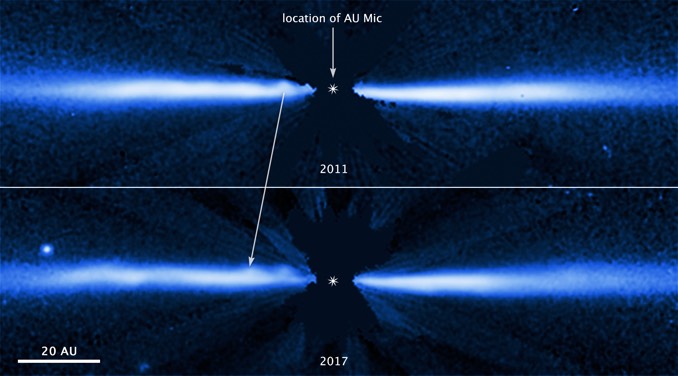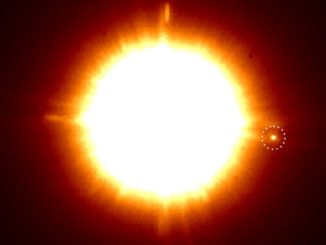
Image: NASA, ESA, J. Wisniewski (University of Oklahoma), C. Grady (Eureka Scientific), and G. Schneider (Steward Observatory)
Observations by the Hubble Space Telescope and the European Southern Observatory’s Very Large Telescope raise the possibility that young planets orbiting red dwarfs – the most common stars in the galaxy – may not be able to accumulate the water and organic compounds necessary for the evolution of life as it’s known on Earth. If so, the Milky Way may be a bit lonelier than previously thought.
That’s because huge blobs of material plowing through protoplanetary discs around such stars could push small particles, possibly containing water and other volatiles, out of the systems and away from young planets in the process of forming, effectively preventing the slow but steady accumulation of such materials over hundreds of millions of years.
At least, that appears to be the case for the disc around the young, 23-million-year-old dwarf star AU Microscopii (AU Mic) some 32 light years away in the constellation Microscopium. Fast-moving blobs of material appear to be ejecting particles at a rate that will dissipate the disc within about 1.5 million years. As a result, icy materials from comets and asteroids could be completely cleared out in what amounts to the blink of an eye in a solar system’s history.

The Hubble Space Telescope was able to track one of the blobs of gassy debris in question, showing it is moving through the disc at nearly 15,000 mph, covering about 820 million miles between 2011 and 2017. It is not yet known where the blobs originate but they may be ejected from AU Mic during energetic outbursts common to dwarf suns.
“These observations suggest that water-bearing planets might be rare around red dwarfs because all the smaller bodies transporting water and organics are blown out as the disk is excavated,” said Carol Grady of Eureka Scientific in Oakland, California, a co-investigator on the Hubble observations.
Earlier observations with the Kepler space telescope and other instruments indicate rocky worlds are common around dwarf stars with many found orbiting in the habitable zones of their host suns where water can exist as a liquid on the surface. But if the disc-thinning blobs of debris seen in the AU Mic system are commonplace, the number of habitable worlds across the Milky Way would be sharply reduced.
“The fast dissipation of the disc is not something I would have expected,” Grady said. “Based on the observations of discs around more luminous stars, we had expected discs around fainter red dwarf stars to have a longer time span. In this system, the disc will be gone before the star is 25 million years old.”



